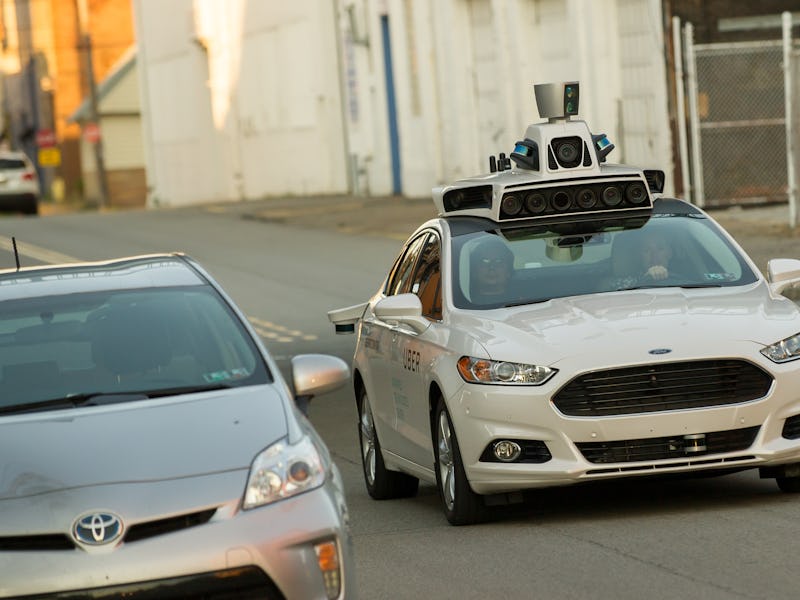The Obvious Thing Holding Back Driverless Cars? Car Companies
What's holding back autonomy progression? Competition.

The race to build the first commercially available self-driving car is underway. Manufacturers may have different ideas about what these cars may look and operate like, but one thing’s for sure: they’re going to need data, and lots of it. Manufacturers will benefit from sharing self-driving car map data, but communication issues and technology differences make it easier said than done.
“It’s going to be a costly business and we’re talking about the whole country,” Dr. Jianxiong Xiao, former assistant professor at Princeton University and founder of self-driving car company AutoX, tells Inverse. “It’s going to be a big deal for them.”
The dream is that cars will automatically produce their own maps by sensing the world around them and passing that data onto the manufacturer, in turn making autonomous cars safer for all. However, at the moment, cellular speeds aren’t fast enough to transmit full maps, and companies are having to develop their own compression systems to get the job done.
“It is very unlikely that we will see universal sharing of mapping data in the short term (whilst it would be greatly beneficial),” Aaron Dale, senior analyst at IHS Markit, tells Inverse.
The race is on to develop 5G cellular networks capable of supporting these data transfers at faster speeds. The sheer quantity of data produced by these cars will heavily outweigh current demands. Today, the average person generates around 650 megabytes of data per day. With its multitude of sensors, an autonomous car will generate around 4,000 gigabytes per day.
“Data will change the entire driving experience going forward,” Intel CEO Brian Krzanich said on stage at November’s Los Angeles Auto Show. “Data is the new oil.”
But beyond the networking troubles, automakers are also struggling with maps that have yet to be standardized, particularly as many are working toward full autonomy using different sets of hardware and software. On the hardware side, systems are being developed that use any combination of cameras, radar, lidar, and ultrasonic sensors. The chosen hardware design will have an effect on which sort of data is needed to navigate.
“If they are very good at algorithm, very good at software, they do not need to depend too much on the map,” Xiao says. “If their technology is not that mature and they need a lot of annotated data, they need a very high definition shading map.”
Waymo, Xiao explains, is at one end of this spectrum. The company is creating highly detailed maps using a lidar sensor, and this means the process can take a lot longer. The sensor bounces lasers off objects in all different directions, measuring the time it takes the laser to reach an object to judge its distance. This process builds a map of the world that looks like this:
A Waymo self-driving car map.
But this doesn’t tell the computer what the object actually is. Waymo is employing human annotators to look through this data and tag objects like stoplights and lampposts, so the car knows how to move when near the object.
At the less detailed end of the spectrum is Mobileye, a company that Dale lists as one that has set up its own ways of transmitting map data. The company has entered into a partnership with BMW and Volkswagen to rapidly build up a large-scale autonomous car map of the world that will help autonomous cars using Mobileye’s system to navigate.
“The crowdsourced maps like Mobileye, they’re less detailed so it costs less,” Xiao says.
The two automakers will supply Mobileye with data from its advanced driver-assistance systems, which are used to assist the driver in emergency braking and other situations. These systems use a camera feed to interpret the world, sends this data to the cloud in a compressed format, analyzes the data and adds it to the work-in-progress map database, known as the Roadbook.
The car has an in-vehicle version of the database, so when it collects a new sample, it checks the database to measure the differences and only transmits the changes to Mobileye. This means the car transmits only around 10 kilobytes of data per kilometer on average.
Mobileye-powered autonomous cars will use the Roadbook to help navigate. Lucid Motors, which is expected to use two EyeQ4 chips in its $52,500 Lucid Air vehicle, announced in December that it would benefit from the Roadbook.
They’re baby steps, but a solution is on the way. When communications improve and company strategies become clearer, we may start to see the limited forms of cooperation necessary to make cars safer.
“There is a critical mass of automakers and physical users that would make this type of platform work, which would require only a small percentage of vehicles on the road,” says Dale.